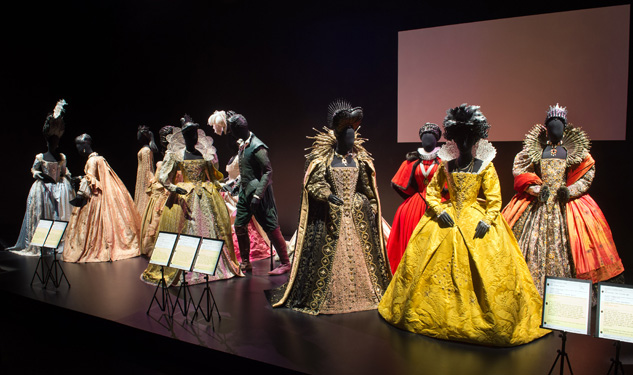
- Fashion
Deborah Nadoolman Landis And The Art Of The Hollywood Costume
It might not be surprising to learn that Deborah Nadoolman Landis is the costume designer responsible for the clothes seen in such classics as The Blues Brothers, Animal House and Trading Places; those films are after all directed by her husband John Landis. But the Academy Award nominated designer is also responsible for such iconic items as Harrison Ford’s fedora in Indiana Jones and the red leather jacket that Michael Jackson wore in the Thriller video and she was twice president of the Costume Designers Guild. She is the driving force behind the comprehensive Hollywood Costumes exhibit currently on view at LACMA’s historic ex-May Company building. The HFPA’s Michele Manelis caught up with her to talk about the costume retrospective.
There are many unsung heroes in Hollywood. Arguably, one of the most under-rated professions is that of the costumer. And yet without their unique vision and painstaking attention to detail, such iconic and indelible images from movies as diverse as Cleopatra to Indiana Jones simply wouldn’t exist.
Deborah Nadoolman Landis, Academy Award-nominated costume designer (Coming to America) brings to life classic and contemporary Hollywood at the current exhibition, Hollywood Costume, held at the future site of the Academy Museum at LACMA, in the historical May Co. building on Wilshire, organized by the Victoria and Albert Museum London. “They say you can’t be a prophet in your own land,” says Landis. She is the founding director of UCLA’s David C. Copley Center of Costume Design, and also happens to be the wife of acclaimed director, John Landis. Ironically, the collection she has curated has toured the world and until recently it appeared as though the Hollywood exhibit would never see the light of day in the very city it was inspired by. “I’ve been in pre-mourning that this exhibition wouldn’t come to LA. I’ve been touring this around the world for two years and when it finally came here, I was so relieved that I wept,” she says. “This is my life’s work.”
The collection features 150 costumes and offers a ‘something for everyone’ appeal. On display is Judy Garland’s blue and white checkered pinafore from The Wizard of Oz, Elizabeth Taylor’s gold ensemble from Cleopatra, an array of ornate costumes from the Elizabethan era, and Darth Vader’s cape from The Empire Strikes Back.
“We start with Charlie Chaplin from The Tramp in 1914 and we end with Captain America: Winter Soldier, in 2014. We are representing 100 years of costumes in Hollywood.” The assembled compilation was a labor of love for Landis. “There were some touchstones I knew I wanted like Marilyn Monroe in The Seven Year Itch, and Some Like it Hot. The Chaplin costume from The Tramp is incredible because it’s loaned from his family and came from Switzerland. It’s the family’s own costume so that’s very touching to me. There were others, like the Ascot dress (from My Fair Lady worn by Audrey Hepburn) in the Debbie Reynolds collection that she promised us but when the hammer came down at that auction and it went to a private collector, I couldn’t find it.”
It’s a fascinating presentation the magnitude of which hasn’t yet been witnessed. Landis’ unorthodox artistry is on show and she leaves no stone unturned when maximizing the space. There are video monitors featuring interviews with the likes of Quentin Tarantino to Meryl Streep, and she mixes time periods – Marlene Dietrich from the 1930s Morocco lights a cigarette for Sharon Stone in her career-defining scene in Basic Instinct.
“It has the grandeur of a show that happens once in a generation. I’m 62 years old and when I was 22 I went to the 1974 Diana Vreeland exhibition at the Metropolitan Museum of Art, in New York, but her focus was on glamour and mine is on costume design.
“This is a once in a generation exhibition. It won’t happen again for a very, very long time. 63 lenders, 150 costumes that means when the show is over on March 2nd and these costumes will go back to Asia, The Emirates, and Europe. It’ll be a long time before anyone collects them all again.”
In honoring a century of costumes, how did Landis go about the selection process?
“Well, in 2007, when my mom was alive I asked her, ‘What’s your favorite movie, mom? I asked my mother-in-law the same question, along with my kids and my husband. Then I looked at the Academy Award nominations for costume design, but more importantly it was from the best movies and best performances because it’s the stories that mean so much to us.”
It isn’t until you stand in front of these iconic costumes – without the actor inhabiting them – that you understand the importance of their contribution as a stand-alone piece to the movies in which they appear. “Costume designers are invisible. We don’t have publicists, we work for hire so we don’t own anything, not even our sketches or our designs nor when they’re replicated on dolls or in fashion. We are not mentioned in fashion magazines but we help create the story and the people who inhabit the clothes. That’s what this exhibition is about,” she says. With a whiff of frustration she continues, “I could never figure out why costumers don’t get the respect they deserve. We’re with the actor who is in the middle of the frame, and usually that actor is not naked,” she laughs. “But with them we’ve created an entirely new person; we’re a partner in their transformation. Hollywood Costume is our contribution to popular culture.”
To see more costumes CLICK HERE!
Michele Manelis

